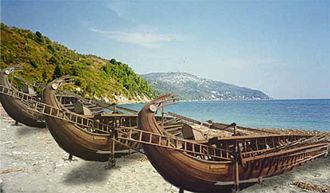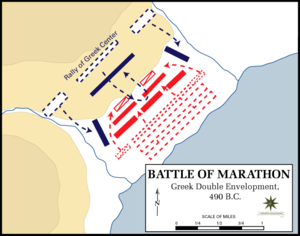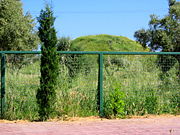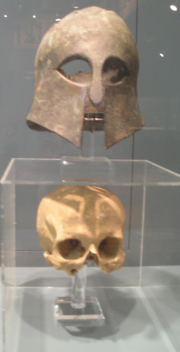Battle of Marathon
2008/9 Schools Wikipedia Selection. Related subjects: Ancient History, Classical History and Mythology
| Battle of Marathon | |||||||||
|---|---|---|---|---|---|---|---|---|---|
| Part of the Greco-Persian Wars | |||||||||
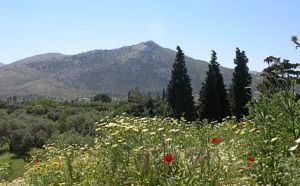 The plain of Marathon today |
|||||||||
|
|||||||||
| Belligerents | |||||||||
| Athens, Plataea |
Achaemenid Empire | ||||||||
| Commanders | |||||||||
| Miltiades the Younger, Callimachus †, Arimnestus |
Datis †?, Artaphernes |
||||||||
| Strength | |||||||||
| 7,000 to 10,000 Athenians, 1,000 Plataeans |
20,000 to 60,000 a | ||||||||
| Casualties and losses | |||||||||
| 192 Athenians, 11 Plataeans (Herodotus) |
6,400, 7 ships captured (Herodotus) |
||||||||
| a These are modern consensus estimates. Ancient sources give numbers ranging from 20,000 to 60,000, though these numbers may not be accurate due to a modern perception that ancient historians may have exaggerated Persian numbers. | |||||||||
|
|||||
The Battle of Marathon ( Greek: Μάχη τοῡ Μαραθῶνος, Machê tou Marathônos) during the Greco-Persian Wars took place in 490 BC and was the culmination of King Darius I of Persia's first full scale attempt to conquer the remainder of Greece and incorporate it into the Persian Empire, which would secure the weakest portion of his western border. Most of what is known of this battle comes from the Greek historian Herodotus in his Histories. In Persian sources, there is no mention of such a battle, but then again there are very few surviving Achaemenid Persian sources in general.
According to re-written Greek and Latin manuscripts that are estimated to be about a thousand years old and are attributed to Ancient Greek historians, Darius first sent Mardonius, in 492 BC, via a land route to Europe to strengthen Persia's hold of Thrace and Macedon, which had been weakened by the Ionian Revolt. Although successful, most of this force perished in a storm off Mount Athos, and the remainder was forced to return to Asia, losing men along the way. In 490 BC, Datis and Artaphernes were sent in a maritime operation to subjugate the Cyclades islands in the central Aegean and punish Eretria and Athens for their assistance in the Ionian Revolt. Eretria was besieged and fell; the fleet then landed in Marathon bay. There they were defeated by a small force of Athenian and Plataean hoplites, despite their numerical advantage. The long run of Pheidippides, the messenger who conveyed news of the victory to Athens, became the inspiration for the marathon race, which was first staged at the 1896 Olympic Games.
Background
In 511 BC, with the aid of Cleomenes I, King of Sparta, the Athenian people expelled Hippias, the tyrant ruler of Athens. With Hippias' father Peisistratus, the family had ruled for 36 out of the previous 50 years and intended to continue Hippias' rule. Hippias fled to Sardis to the court of the nearest Persian satrap, Artaphernes, and promised control of Athens to the Persians if they were to restore him. When the Athenians demanded he be expelled, the satrap suggested they restore him to power. This gave assistance, in the form of 20 boats, to the Ionian cities embroiled in the Ionian Revolt (499 BC–494 BC). Hippias had probably fled to the court of King Darius during the revolt.
The city of Eretria had also given assistance to the Ionians. Though the assistance sent by the two cities was not very effective, it alarmed Darius and he wished to punish the cities. In 492 BC, he dispatched an army under the command of his son-in-law, Mardonius, to Greece. Mardonius conquered Thrace and thus compelled Alexander I of Macedon to relinquish his kingdom again to Persia. However, while in route south to the Greek city-states, the Persian fleet was wrecked in a storm in Cape Athos, losing 300 ships and 20,000 men. Mardonius was forced to retreat to Asia. Attacks by Thracian tribes inflicted losses on the retreating army.
Darius learned, perhaps through Hippias, that the Alcmaeonidae, a powerful Athenian family, were opposed to Miltiades, who at the time was the most prominent politician of Athens. While they were not ready to help reinstate Hippias (they had helped overthrow him), they probably believed a Persian victory was inevitable and wanted to secure a better position in the new political regime that was to follow the Persian conquest of Athens. Darius wished to take advantage of this situation to conquer Athens, which would isolate Sparta and, by handing him the remainder of the Greeks in the Aegean, would consolidate his control over Ionia. In order for the Athenians to revolt, two things would need to happen: the populace would need to be encouraged to revolt, and the Athenian army would have to leave Athens so that they could not crush the revolt.
Darius decided to send a purely maritime expedition led by Artaphernes, son of the satrap to whom Hippias had fled and Datis, a Median admiral—Mardonius had been injured in the prior campaign and had fallen out of favour—with the intention to punish Naxos (whose resistance to Persian attack in 499 BC led to the Ionian revolt) and force Eretria and Athens to submit to Darius or be destroyed.
Size of opposing forces
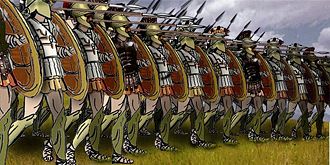
According to Herodotus, the fleet sent by Darius consisted of 600 triremes, whereas, according to Cornelius Nepos, there were only 500. The historical sources do not reveal how many transport ships accompanied them, if any. According to Herodotus, 3,000 transport ships accompanied 1,207 ships during Xerxes' invasion in 480 BC. Stecchini estimates the whole fleet comprised 600 ships altogether: 300 triremes and 300 transports; while Peter Green says there were 200 triremes and 400 transports. Ten years earlier, 200 triremes failed to subdue Naxos, so a 200 or 300 trireme fleet is perhaps inadequate for all three objectives.
Herodotus does not estimate the size of either army. Of the Persian army, he says they were a large infantry that was well packed. Among ancient sources, the poet Simonides, another near-contemporary, says the campaign force numbered 200,000; while a later writer, the Roman Cornelius Nepos estimates 200,000 infantry and 10,000 cavalry, of which only 100,000 fought in the battle, while the rest were loaded into the fleet that was rounding Cape Sounion; Plutarch and Pausanias both independently give 300,000, as does the Suda dictionary; Plato and Lysias assert 500,000; and Justinus 600,000.
Modern historians have also made various estimates. As Kampouris has noted, if the 600 ships were warships and not transport ships, with 30 epibates soldiers in each ship—the ships' foot soldiers that formed and defended from boarding parties during the sea battles—(typical for Persian ships after the Battle of Lade; this was how many they had during Xerxes' invasion), the number 18,000 is attained for the troops. But since the fleet did have transport ships, it must have at least carried the Persian cavalry. Whereas Herodotus claims the cavalry was carried in the triremes, the Persian fleet had dedicated ships for this undertaking, and according to Ephorus, 800 transports accompanied Xerxes' invasion fleet 10 years later. Estimates for the cavalry are usually in the 1,000–3,000 range, though as noted earlier Cornelius Nepos gives 10,000.
Other modern historians have proposed other numbers for the infantry. Bengtson estimates there were no more than 20,000 Persians; Paul K. Davis estimates there were 20,000 Persians; Martijn Moerbeek estimates there were 25,000 Persians; How & Wells estimate 40,000 Persians landed in Marathon; Bussolt and Glotz talk of 50,000 battle troops; Stecchini estimates there to have been 60,000 Persian soldiers in Marathon; Kleanthis Sandayiosis talks of 60,000 to 100,000 Persian soldiers; while Peter Green talks of 80,000 including the rowers; and Christian Meier talks of 90,000 battle troops. Scholars estimating relatively small numbers for Persian troops argue that the army could not be very big in order to fit in the ships. The counterargument of scholars who claim large numbers is that if the Persian army was small, then the Eretrians combined with the Athenians and Plateans could match it, and possibly have sought battle outside Eretria. Naxos alone could field "8,000 shields" in 500 BC and with this force successfully defended against the 200-ship Persian invasion 10 years earlier.
Modern historians favour that the whole Greek army numbered c. 10,000 hoplites, with the Athenian hoplites numbered at c. 9,000 and the little Platean contingent at c. 1,000 men. Others have given around 7,000–8,000, for the whole Greek army and others 11.000 while Justinus and Cornelius Nepos both give 10,000 as the number of the Greeks. According to the Suda Dictionary Herodotus tells us that at the battle of Plataea eleven years later the Athenians sent 8,000 hoplites while others were at the same time engaged as epibates in the fleet that later fought at the battle of Mycale. Pausanias noticed in the trophy of the battle the names of former slaves who were freed in exchange for military services. Also, it is possible that metics, non-Athenian Greeks residing in Athens, were drafted since they had military obligations to Athens in times of great emergency (for example in 460 BC). However, for Marathon, this is not mentioned by any surviving source, and their number in Athens was not as significant in 490 BC as it became later in the century when Athens became head of the Delian League.
Athens at that time could have fielded at least four times the force it did had it also chosen to send light troops consisting of the lower classes, for ten years later at the Battle of Salamis it had a 180 trireme fleet that was manned by 32,000 rowers, and had lost some 90 ships earlier in the Battle of Artemisium. Why this did not happen has been subject to speculation. Kampouris, among others, notes that the political leanings of the lower classes were unreliable. After the Ionic revolt had shown the general unreliability of tyrants to the Persian empire, Artaphernes, in 494 BC, had changed the regime of the Ionian city-states from tyranny to democracy, thus setting an example that was later copied, among others, by the Second Athenian Alliance and Alexander the Great. There the power rested on the poor with the Persian army in place to rein in any move that threatened Persia's position. Some of the poor who remembered Peisistratus well, since he had given them jobs, probably hoped for a victory of the Persians and a change in regime to give them more power, which is one of the reasons Hippias ordered the landing in Marathon where the vast majority of local inhabitants were from these social classes. On the other hand, the Persian army hoped for an internal revolution in Athens so as to have an easy victory as in Eretria.
Before the battle
For five days, the armies peacefully confronted each other, hoping for developments, with the Athenian army slowly narrowing the distance between the two camps, with pikes cut from trees covering their sides against cavalry movements. Since time worked in favour of the Athenians, it probably was the Persian army that decided to move. On the sixth day, when Miltiades was the prytanevon general, a rather bureaucratic rank consistent with the duty officer of modern armies—either September 12 or possibly August 12 490 BC reckoned in the proleptic Julian calendar—Artaphernes decided to move and attack Athens. The Athenians came to know from two Ionian defectors that the Persian cavalry was gone. Where and why, along with the Persian battle plan, has been a matter of debate. Several historians have supposed that this was either because the cavalry had boarded the ships, that it was inside the camp since it could not stay in the field during the night, or because it was moving along with the whole army among the northern route to reach the walls of Athens. It should be noted that Herodotus does not mention that the army was boarding the ships. Some light is given by the "χωρίς ἰππεῖς" (=without cavalry) entry of the Suda dictionary. It states: "The cavalry left. When Datis surrendered and was ready for retreat, the Ionians climbed the trees and gave the Athenians the signal that the cavalry had left. And when Miltiades realized that, he attacked and thus won. From there comes the above-mentioned quote, which is used when someone breaks ranks before battle".
According to Herodotus, by that point the generals had decided to give up their rotating leadership as prytanevon generals in favor of Miltiades. He chose the day his tribe was leading, for the attack, perhaps because he wanted to bear the full responsibility for the battle. He decided to move against the Persians very early in that morning. He ordered two tribes that were forming the centre of the Greek formation, the Leontis tribe led by Themistocles and the Antiochis tribe that was led by Aristides, to be arranged in the depth of 4 ranks while the rest of the tribes in the sides were in 8 men ranks. The distance between the two armies had narrowed to a distance not less than 8 stadia or about 1,500 meters, which they covered running shouting their war cry, "Ελελευ! Ελελευ!" (Eleleu, Eleleu), much to the surprise on the Persians who "in their minds they charged the Athenians with madness which must be fatal, seeing that they were few and yet were pressing forwards at a run, having neither cavalry nor archers." It is also a matter of debate whether the Greek army ran the whole distance or marched until they reached the limit of the archers' effectiveness, the "beaten zone", or roughly 200 meters, and then ran towards the ranks of their enemy. Proponents of the latter opinion note that it is very hard to run that large a distance carrying the heavy weight of the hoplitic armor, estimated at 32 kilograms (70.5 pounds). Proponents of the former opinion note the following arguments: the Ancient Greeks—as indicated by the surviving statues—were in very good physical condition (the hoplite run had recently become an Olympic sport), and if they had run the entire distance, it would have been covered in about 5 minutes, whereas if they had marched, it would have probably taken 10, enough time for the Persians to react, which they did not.
Composition and formation of Persian forces
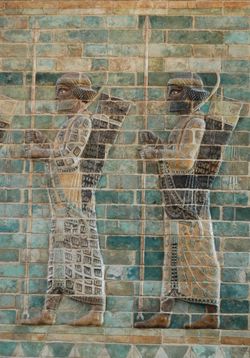
The bulk of Persian infantry were likely Takabara lightly armed archers. Several lines of evidence support this. First of all, Herodotus does not mention a shield wall in Marathon, that was typical of the heavier Sparabara formation, as he specifically mentions in the Battle of Plataea and the Battle of Mycale. Also, in the depiction of the Battle of Marathon in the Stoa that was dedicated a few years later in 460 BC when most veterans of the war were still alive, that is described by Pausanias, only Takabara infantry are depicted. Finally, it seems more likely that the Persians would have sent the more multipurpose Takabara soldiers for a maritime operation than the specialized Sparabara heavy (by Persian standards) infantry. The Takabara troops carried a small woven shield, probably incapable of withstanding heavy blows from the long spears of the hoplites. The usual tactic of the Persian army was for the archers to shoot volleys of arrows to weaken and disorganise their enemy, then their excellent cavalry moved in to deliver the coup de grace. On the other hand, the Ασπις ( aspis), the heavy shield of the hoplites, was capable of protecting the man who was carrying it (or more usually the man on his left) from both the arrows and the spears of its enemies. The Persians were also at a severe disadvantage due to the size of their weapons. Hoplites carried much longer spears than their Persian enemies, extending their reach as well as protecting them. Persian armies would usually have elite Iranian troops in the centre and less reliable soldiers from subject peoples on the sides of the formation. It is confirmed by Herodotus that this is how the Persian army was arrayed in the battlefield.
During the Ionian revolt, the phalanx was seriously weakened by the arrows of the Persian archers before it reached hand-to-hand combat with them—where it excelled—because it moved slowly in order to maintain formation. This is why Miltiades, who had great experience with the Persian army since he was forced to follow it during its campaign in Scythia in 513 BC, ordered his army to run. This could have meant that they could end up fighting in disordered ranks. Herodotus, however, mentions in the description of the battle that the retreat of the center happened in order, meaning that the formation was not broken during the initial rush. This is supported by the fact that there were few casualties in that phase of the battle. The Greek centre was reduced to four ranks, from the normal eight. The wings maintained their eight ranks. If Miltiades only wanted to extend the line and prevent the Persian line from overlapping the Greeks, he would have weakened, uniformly, the whole army so as not to leave weak points. But Herodotus categorically states that it was a conscious decision to strengthen the sides probably in order to have a strong force to defeat the weaker-in-quality Persian sides.
![The initial positions of the troops before the clash. The Greeks (blue) have pulled up their wings to bolster the corners of their significantly smaller centre in a ]] shape. The Persian fleet (red) waits some way off to the east. This great distance to the ships played a crucial role in the later stages of the battle.](../../images/749/74947.png)
The front of the Greek army numbered 250 × 2 (for the centre tribes) plus 125 × 9 (for the side tribes and the Plateans) = 1,625 men. If the Persians had the same density as the Greeks and were 10 ranks strong then the Persian army opposing the Greeks numbered 16,000 men. But if the front had a gap of 1.4 meters between soldiers compared to 1 meters for every Greek and had a density of 40 to 50 ranks as seems to be the maximum possible for the plain—the Persian army had even fought in 110 ranks—then the Persian army numbered 44,000 to 55,000. If the Persian front numbered 2,000 men and they fought in 30 ranks (as Xenophon in Cyropaedia claims) they numbered 60,000. Kampouris suggests it numbered 60,000 since that was the standard size of a major Persian formation.
The enemies engage in hand to hand combat
As the Greeks advanced, their strong wings drew ahead of the center, which retreated according to plan. The retreat must have been significant since Herodotus mentions that the centre retreated towards Mesogeia, not several steps. However, ranks did not break since the overall casualties were low, and most were sustained during the last phase of the battle. The Greek retreat in the centre, besides pulling the Persians in, also brought the Greek wings inwards, shortening the Greek line. The result was a double envelopment, and the battle ended when the whole Persian army, crowded into confusion, broke back in panic towards their ships and were pursued by the Greeks. The sides were left open so that the Persian ranks would break, since even a desperate army that maintained numerical advantage after a battle could still defeat its enemy. Some, unaware of the local terrain, ran towards the swamps where they drowned.
Herodotus records that 6,400 Persian bodies were counted on the battlefield, and it is unknown how many perished in the swamps. Also, seven Persian ships are mentioned captured though none are mentioned sunk. The Athenians lost 192 men and the Plateans 11, most during the final chase when their heavy armor proved a disadvantage. Among the dead was the polemarch Callimachus and the general Stesilaos. One story documents that Kynaigeirus, brother of the playwright Aeschylus who was also among the fighters, charged into the sea, grabbed one Persian trireme, and started pulling it towards shore. A member of the crew saw him, cut off his hand, and Kynaigeirus died.
It seems that Aeschylus considered that his participation in Marathon was his greatest achievement in life (rather than his plays) since in his gravestone there was the following epigram:
- Αἰσχύλον Εὐφορίωνος Ἀθηναῖον τόδε κεύθει
- μνῆμα καταφθίμενον πυροφόροιο Γέλας·
- ἀλκὴν δ’ εὐδόκιμον Μαραθώνιον ἄλσος ἂν εἴποι
- καὶ βαρυχαιτήεις Μῆδος ἐπιστάμενος
- This tomb the dust of Aeschylus doth hide,
- Euphorion's son and fruitful Gela's pride
- How tried his valor, Marathon may tell
- And long-haired Medes, who knew it all too well.
- μνῆμα καταφθίμενον πυροφόροιο Γέλας·
According to Ctesias, Datis was slain at Marathon. Herodotus, however, has him alive after the battle returning a statue of Apollo to Delos that had earlier been removed by his army, though he does not mention him after the remnant of the army returned to Asia.
Aftermath
As soon as Datis had put to sea, the two centre tribes stayed to guard the battlefield and the rest of the Athenians marched to Athens. A shield had been raised over the mountain near the battle plain, which was either the signal of a successful Alcmaeonid revolution or (according to Herodotus) a signal that the Persian fleet was moving towards Phaliro. They arrived in time to prevent Artaphernes from securing a landing. Seeing his opportunity lost, Artaphernes turned about and returned to Asia. On the next day, the Spartan army arrived, having covered the 220 kilometers (136.7 miles) in only three days. Some modern historians doubt they traveled so fast. The Spartans toured the battlefield at Marathon, and agreed that the Athenians had won a great victory.
The Greek upset of the Persians, who had not been defeated on land for many decades (except by Samagaetes and Scythes, both nomad tribes), caused great problems for the Persians. The Persians were shown as vulnerable. Many subject peoples revolted following the defeat of their overlords at Marathon. Order was not restored for several years.
The dead of Marathon were awarded by the Athenians the special honour of being the only ones who were buried where they died instead of the main cemetery of Athens in Kerameikos. On the tomb of the Athenians this epigram composed by Simonides was written:
- Ελλήνων προμαχούντες Αθηναίοι Μαραθώνι
- χρυσοφόρων Μήδων εστόρεσαν δύναμιν
which means
- The Athenians, as defenders of the Hellenes, in Marathon
- destroyed the might of the golden-dressed Medes
(translation by Major General Dimitris Gedeon, HEAR)
The tomb was excavated in the 1880s by German archaeologists. The team, however, did not include any anthropologists, and were therefore unable to determine the number of bodies in the tomb. The same team also found a ditch containing large numbers of hastily buried human bones which was identified as the burial place of the Persians.
For the Athenians, the victory gave confidence to the people. Two years later ostracism was exercised for the first time, its first victim being a friend of Peisistratus.
Conclusion
Marathon was in no sense a decisive victory over the Persians. However, it was the first time the Greeks had bested the Persians on land, and "their victory endowed the Greeks with a faith in their destiny that was to endure for three centuries, during which western culture was born." (J.F.C. Fuller, A Military History of the Western World). John Stuart Mill's famous opinion is that the Battle of Marathon was more important an event for British history than the Battle of Hastings. Kampouris sees the battle as a failure of purely maritime operations, due to their inherent weaknesses.
The longest-lasting legacy of Marathon was the double envelopment. Some historians have claimed it was random rather than a conscious decision by Miltiades. As they say, was it really Cannae before Cannae? In hoplitic battles, the two sides were usually stronger than the centre because either they were the weakest point (right side) or the strongest point (left side). However, before Miltiades (and after him until Epaminondas), this was only a matter of quality, not quantity. Miltiades had personal experience from the Persian army and knew its weaknesses. As his course of action after the battle shows (invasions of the Cyclades islands), he had an integrated strategy upon defeating the Persians, hence there is no reason he could have not thought of a good tactic. The double envelopment has been used ever since, such as when the German Army used a tactic at the battle of Tannenberg during World War I similar to that used by the Greeks at Marathon.
Date of the battle
Herodotus mentions for several events a date in the lunisolar calendar, of which each Greek city-state used a variant. Astronomical computation allows us to derive an absolute date in the proleptic Julian calendar which is much used by historians as the chronological frame. August Böckh in 1855 concluded that the battle took place on 11 September 490 BC in the Julian calendar, and this is the conventionally accepted date. However, this depends on when the Spartans held their festival and it is possible that the Spartan calendar was one month ahead of that of Athens. In that case the battle took place on 11 August 490 BC. If the battle really occurred in August, temperatures in the area typically reach over 30 degrees Celsius and thus make the marathon run event less plausible.
Legends associated with the battle
A victory that important against a superior enemy was bound to have consequences on religious life. Herodotus mentions that Pheidippides was visited by the god Pan on his way to Sparta for help. He asked why the Athenians did not honour him and Pheidippides promised that they would do so from then on. After the battle, a temple was built to him, and a sacrifice was annually offered. The festival of "Agroteras Thusia", (Thusia means sacrifice) was held at Agrae near Athens, in honour of Artemis Agrotera, in fulfillment of a vow made by the city, before the battle, to offer in sacrifice a number of goats equal to that of the Persians slain in the conflict. The number being so great, it was decided to offer 500 goats yearly until the number was filled. Xenophon notes that at his time, 90 years after the battle, goats were still offered yearly.
Plutarch mentions that the Athenians saw Theseus, the mythical hero of Athens leading the army in full battle gear in the charge against the Persians and indeed he was depicted in the mural of the Poikele Stoa fighting for the Athenians along with the twelve gods and other heroes, Pausanias tells us that those who fought at Marathon:
| “ | They say too that there chanced to be present in the battle a man of rustic appearance and dress. Having slaughtered many of the foreigners with a plough he was seen no more after the engagement. When the Athenians made enquiries at the oracle the god merely ordered them to honour Echetlaeus (He of the Plough-tail) as a hero. Pausanias 1.32.5 | ” |
Furthermore Pausanias mentions that at times ghosts were seen and heard to engage in battle in Marathon. This phenomenon appears to have also been reported in the modern era: according to newspapers of the time in the year 1930, visitors to the region claimed to have heard a sound of metal clashes and screams coming from the battlefield. This event is usually mentioned in books about paranormal events in Greece and is usually associated with the drosoulites phenomenon of Southern Crete, though the scientific explanation given for the latter (a mirage from North Africa) can not explain the former event.
Another tale from the conflict is of the dog of Marathon. Claudius Aelianus relates that one hoplite brought his dog to the Athenian encampment. The dog followed his master to battle and attacked the Persians at his master's side. He also informs us that this dog is depicted in the mural of the Poikile Stoa.
Marathon run
According to Herodotus, an Athenian runner named Pheidippides ran from Athens to Sparta to ask for assistance before the battle. This event was later turned into the popular legend that Pheidippides ran from Marathon to Athens.The traditional story relates that Pheidippides, an Athenian herald, ran the distance between the battlefield by the town of Marathon to Athens to announce the Greek victory over Persia in the Battle of Marathon (490 BC) with the word "Nenikēkamen!" (Attic: Νενικήκαμεν (We were victorious!) and died on the spot. Most accounts incorrectly attribute this story to the historian Herodotus, who wrote the history of the Persian Wars in his Histories (composed about 440 BC). The story first appears in Plutarch's On the Glory of Athens in the 1st century AD, who quotes from Heracleides of Pontus' lost work, giving the runner's name as either Thersipus of Erchius or Eucles. Lucian of Samosata (2nd century AD) also gives the story but names the runner Philippides (not Pheidippides). It should be noted that in some medieval codices of Herodotus the name of the runner between Athens and Sparta before the battle is given as Philippides and in a few modern editions this name is preferred.
Another point of debate is the path taken by the runner. There are two exits from the battlefields. One is towards the south that follows modern-day Marathonos avenue leading through Pikermi over the pass of Stavros Agias Paraskevis and down modern day Messogeion avenue to Athens, which is 40.8 kilometers (25.3 miles) long—following the ancient roads, the modern road has been lengthened somewhat to accommodate vehicular traffic to and from Mesogeia. The other is towards the north, over the modern village of Vranas, up the relatively high mountain pass towards modern day Dionyssos and the northern suburbs of Athens, which is 34.5 kilometers (21.4 miles) long. It is more likely that the runner followed the safer, shorter but more tiring northern route than the longer but unsafe southern route. For the first modern marathon during the 1896 Olympics, the southern route was chosen probably because it was the main modern route between Marathon and Athens. That event was won by the Greek Spyros Loues who, being a local, knew that he had to conserve energy to pass the Stavros Agias Paraskevis pass, unlike his foreign competitors who were unaware of the terrain and abandoned the race there. The race today is run over a distance of 42.195 kilometres (26.219 mi).
A popular legend about the battle and the run was recorded by Andreas Karkavitsas in the 19th century and also Linos Politis
| “ | On the plain of Marathon there was once a big battle. Many Turks with many ships came to enslave the land and from there pass to Athens... The blood turned into a river, and reached from the roots of Vranas to Marathon on the other side. It reached the sea and painted the waves red. Lots of lamentation and evil took place. In the end the Greeks won... Then two men ran to bring the news to Athens. One of them went on horseback and the other on foot and in full gear. The rider went towards Halandri and the one on foot towards Stamata. Swift-footed he went up Aforesmos and down towards the village. As women saw him, they ran towards him: "Stop!" they shouted - stamata! (Greek for stop). They wanted to ask what happened in the battle. He stopped a moment to catch his breath and then took the road again. Finally he reaches Psychiko. There he was almost near death , his feet were shaking, he felt like falling down. But he composed himself, took a deep breath, continued and finally reached Athens. "We won," he said, and immediately he fell down and died. The rider had yet to come. But there where the foot runner stopped and took a breath is named after his act. The first village is called Stamata and the second Psychiko. |
” |
In popular culture
- Robert Graves' poem The Persian Version ridicules the supposed Persian view of the battle as a "minor affair".
- Alice Leader's 2004 children's novel Shield of Fire ( ISBN 9780141315287) focuses on the Persian invasion and the Battle of Marathon as seen by a young Greek girl.
- The film The 300 Spartans refers to Marathon through spoken recollections by the character of Xerxes.
- The Macintosh game Marathon loosely references the Battle of Marathon throughout the game.
